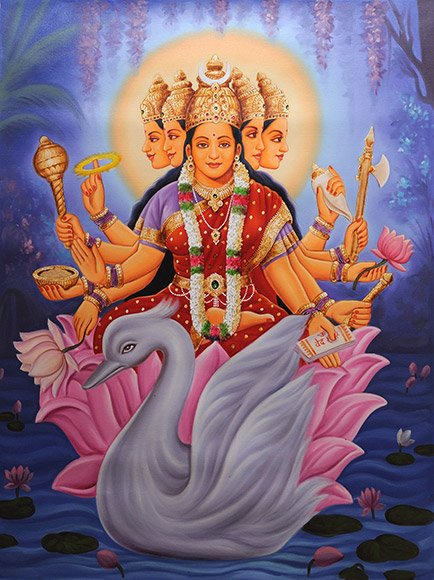Bhadrika, Bhadrikā: 15 definitions
Introduction:
Bhadrika means something in Buddhism, Pali, Hinduism, Sanskrit, Jainism, Prakrit, biology. If you want to know the exact meaning, history, etymology or English translation of this term then check out the descriptions on this page. Add your comment or reference to a book if you want to contribute to this summary article.
In Hinduism
Chandas (prosody, study of Sanskrit metres)
Source: Shodhganga: a concise history of Sanskrit Chanda literature1) Bhadrikā (भद्रिका) is the alternative name Aparavaktra and Uttarāntikā, both Sanskrit metres (chandas) mentioned by Hemacandra (1088-1173 C.E.) in his auto-commentary on the second chapter of the Chandonuśāsana. Bhadrikā corresponds to Aparavaktra (according to Bharata) as well as Uttarāntikā. Hemacandra gives these alternative names for the metres by other authorities (like Bharata), even though the number of gaṇas or letters do not differ.
2) Bhadrikā (भद्रिका) refers to one of the 135 metres (chandas) mentioned by Nañjuṇḍa (1794-1868 C.E.) in his Vṛttaratnāvalī. Nañjuṇḍa was a poet of both Kannada and Sanskrit literature flourished in the court of the famous Kṛṣṇarāja Woḍeyar of Mysore. He introduces the names of these metres (e.g., Bhadrikā) in 20 verses.
Source: Journal of the University of Bombay Volume V: Apabhramsa metres (2)Bhadrikā (भद्रिका) refers to a variation Gīti, which itself is a variety of Gāthā: one of the oldest Prakrit meters probably developed out of the epic Anuṣṭubh, as discussed in books such as the Chandonuśāsana, Kavidarpaṇa, Vṛttajātisamuccaya and Svayambhūchandas.—Among the metres derived from the Gāthā, Gīti, Upagīti and Udgīti are most important. Gīti is made with two first halves of a Gāthā. [...] When a pañcamātra is substituted for the caturmātra which stands in the 7th place (i.e., for mātrās 25-28) in each half of a Gīti, it is called Ripucchandas; when it is substituted for the caturmātra in the 3rd place (i.e., for mātrās 9-12) in each half, it is called Lalitā; and when it is substituted for both, the Gīti is called Bhadrikā.

Chandas (छन्दस्) refers to Sanskrit prosody and represents one of the six Vedangas (auxiliary disciplines belonging to the study of the Vedas). The science of prosody (chandas-shastra) focusses on the study of the poetic meters such as the commonly known twenty-six metres mentioned by Pingalas.
Ayurveda (science of life)
Kalpa (Formulas, Drug prescriptions and other Medicinal preparations)
Source: Shodhganga: Edition translation and critical study of yogasarasamgrahaBhadrikā (भद्रिका) is another name for “Bhadrā” and is dealt with in the 15th-century Yogasārasaṅgraha (Yogasara-saṅgraha) by Vāsudeva: an unpublished Keralite work representing an Ayurvedic compendium of medicinal recipes. The Yogasārasaṃgraha [mentioning bhadrikā] deals with entire recipes in the route of administration, and thus deals with the knowledge of pharmacy (bhaiṣajya-kalpanā) which is a branch of pharmacology (dravyaguṇa).

Āyurveda (आयुर्वेद, ayurveda) is a branch of Indian science dealing with medicine, herbalism, taxology, anatomy, surgery, alchemy and related topics. Traditional practice of Āyurveda in ancient India dates back to at least the first millenium BC. Literature is commonly written in Sanskrit using various poetic metres.
In Buddhism
Mahayana (major branch of Buddhism)
Source: Wisdom Library: Maha Prajnaparamita Sastra1) Bhadrika (भद्रिक) is one of the two sons of Śuklodana, son of Siṃhahanu: an ancient king of the solar clan (āditagotra or sūryavaṃśa) according to Mahāprajñāpāramitāśāstra (chapter VI). Accordingly, “King Śuklodana had two sons: 1) Po t’i (Bhadrika), 2) Y’i cha (Tiṣya)”.
2) Bhadrika (भद्रिक) is the name of the “assistant” (upasthāyaka) of Buddha Krakasunda (or Krakucchanda), according to the Mahāvadānasūtra, as mentioned in an appendix of the 2nd century Mahāprajñāpāramitāśāstra chapter XLI. Each Buddha had his assistant (upasthāyaka), a monk specially attached to his person, entrusted with fanning him, carrying his robe and bowl for alms-round, introducing visitors. The Sanskrit Mahāvadānasūtra has drawn up a list of the assistants who served the last seven Buddhas: Aśoka for Vipaśyin, Kṣemakāra for Śikhin, Upaśanta for Viśvabhuj, Bhadrika for Krakasunda (or Krakucchanda), Svastika for Kanakamuni, Sarvamitra for Kāśyapa, and finally Ānanda for Śākyamuni.

Mahayana (महायान, mahāyāna) is a major branch of Buddhism focusing on the path of a Bodhisattva (spiritual aspirants/ enlightened beings). Extant literature is vast and primarely composed in the Sanskrit language. There are many sūtras of which some of the earliest are the various Prajñāpāramitā sūtras.
Tibetan Buddhism (Vajrayana or tantric Buddhism)
Source: Wisdom Library: Tibetan BuddhismBhadrika (भद्रिक) is the name of a Śrāvaka mentioned as attending the teachings in the 6th century Mañjuśrīmūlakalpa: one of the largest Kriyā Tantras devoted to Mañjuśrī (the Bodhisattva of wisdom) representing an encyclopedia of knowledge primarily concerned with ritualistic elements in Buddhism. The teachings in this text originate from Mañjuśrī and were taught to and by Buddha Śākyamuni in the presence of a large audience (including Bhadrika).

Tibetan Buddhism includes schools such as Nyingma, Kadampa, Kagyu and Gelug. Their primary canon of literature is divided in two broad categories: The Kangyur, which consists of Buddha’s words, and the Tengyur, which includes commentaries from various sources. Esotericism and tantra techniques (vajrayāna) are collected indepently.
In Jainism
General definition (in Jainism)
Source: archive.org: The Jaina IconographyBhadrika (भद्रिक) or Bhadrikapura refers to the birth-place of Śītalanātha: the tenth of twenty-four Tīrthaṃkaras or Jinas, commonly depicted in Jaina iconography.—Śītalanātha was born of a Kṣatriya family of Malaya Kingdom. His birth-place is named Bhadrikapura or Bhadillapura (Madrapura according to one version). His parent’s names were king Dṛḍharatha and Queen Sunandā respectively. His chowri-bearer was called Rājā Sīmandhara.
Source: HereNow4u: Lord Śrī MahāvīraBhadrikā (भद्रिका) is the name of a city visited by Mahāvīra during his sixth year of spiritual-exertion.—The Lord arrived at Bhadrikā city on leaving ‘Śāliśīrṣa’. There he spent the sixth rainy season observing four months of fast and meditation. At the end of the rainy season, the Lord broke his fast outside the city and left for Magadha.

Jainism is an Indian religion of Dharma whose doctrine revolves around harmlessness (ahimsa) towards every living being. The two major branches (Digambara and Svetambara) of Jainism stimulate self-control (or, shramana, ‘self-reliance’) and spiritual development through a path of peace for the soul to progess to the ultimate goal.
Biology (plants and animals)
Source: Google Books: CRC World Dictionary (Regional names)Bhadrika in India is the name of a plant defined with Aerva lanata in various botanical sources. This page contains potential references in Ayurveda, modern medicine, and other folk traditions or local practices It has the synonym Illecebrum lanatum Murr. (among others).
Example references for further research on medicinal uses or toxicity (see latin names for full list):
· Species Plantarum (1753)
· Annales du muséum national d’histoire naturelle (1803)
· Systema Vegetabilium, ed. 13 (1774)
· Bulletin of Miscellaneous Information Kew (1897)
· Journal of Ethnopharmacology (2004)
· Mantissa Plantarum (1771)
If you are looking for specific details regarding Bhadrika, for example side effects, diet and recipes, chemical composition, extract dosage, health benefits, pregnancy safety, have a look at these references.

This sections includes definitions from the five kingdoms of living things: Animals, Plants, Fungi, Protists and Monera. It will include both the official binomial nomenclature (scientific names usually in Latin) as well as regional spellings and variants.
Languages of India and abroad
Sanskrit dictionary
Source: DDSA: The practical Sanskrit-English dictionaryBhadrikā (भद्रिका).—
1) An amulet.
2) = भद्रा (bhadrā) (2) above.
Source: Cologne Digital Sanskrit Dictionaries: Edgerton Buddhist Hybrid Sanskrit DictionaryBhadrika (भद्रिक).—(1) adj. (= Sanskrit bhadra-ka, Pali bhaddaka), felicitous: °keṇa śākyarājena (refers to Śuddhodana, hence not n. pr. (proper name)) Lalitavistara 122.1 (prose, no v.l.; possibly, however, read bhadrakeṇa?); (2) (= Pali Bhaddiya) name of one of the five bhadravargīya monks, q.v. (also Bhadraka, Bhadrajit, qq.v.): Mahāvastu iii.337.5; 339.1; Lalitavistara 1.8; Saddharmapuṇḍarīka 1.10; Divyāvadāna 268.6; (3) (app. not the same as 2, but also = Pali Bhaddiya, 2 in Malalasekara (Dictionary of Pali Proper Names); [Buddhist Hybrid Sanskrit] also Bhaṭṭika, q.v.), name of a Śākyan youth, usually associated with Aniruddha or Mahānāman (2) or both; became a disciple of Buddha: Lalitavistara 229.12; Mahāvyutpatti 3606; Avadāna-śataka ii.112.4; 113.6 ff.; as one of 8 mahāśrāvaka, q.v., (Ārya-)Mañjuśrīmūlakalpa 64.11; see also Lavaṇa- bhadrika, probably not the same; (4) name of a pratyekabuddha: Mahāvastu iii.414.4; (5) name of a yakṣa: Mahā-Māyūrī 66 (living at Bha- drikā); (6) (= Pali Bhaddika, or Bhaddiya), name of a city: °ke nagare Karmavibhaṅga (and Karmavibhaṅgopadeśa) 68.8 (according to Lévi's note, a Chin. version points to Bhadrikā, q.v., but I do not see how it gives any clue to the quantity of the a-vowel); the same city is called Bhadraṃkara Divyāvadāna 123.16; 125.10 ff.; Mūla-Sarvāstivāda-Vinaya i.241.1; ii.32.8; the country containing it is given the same name, Bhadraṃkareṣu janapadeṣu Divyāvadāna 125.16 ff.; compare also Bhadrapura.
--- OR ---
Bhadrikā (भद्रिका).—(compare prec., 6; the same?), name of a city or locality, where the yakṣa Bhadrika (5) lived: Mahā-Māyūrī 66 (°kāyāṃ).
Source: Cologne Digital Sanskrit Dictionaries: Shabda-Sagara Sanskrit-English DictionaryBhadrikā (भद्रिका).—f.
(-kā) 1. An amulet. 2. Name of the second, seventh and twenty days of a lunar fortnight.
Source: Cologne Digital Sanskrit Dictionaries: Monier-Williams Sanskrit-English Dictionary1) Bhadrikā (भद्रिका):—[from bhadraka > bhand] f. an amulet, [Mahābhārata]
2) [v.s. ...] Myrica Sapida, [cf. Lexicographers, esp. such as amarasiṃha, halāyudha, hemacandra, etc.]
3) [v.s. ...] Name of 2 metres, [Colebrooke]
4) Bhadrika (भद्रिक):—[from bhand] m. Name of a prince of the Śākyas, [Buddhist literature] ([varia lectio] bhadraka).
Source: DDSA: Paia-sadda-mahannavo; a comprehensive Prakrit Hindi dictionary (S)Bhadrikā (भद्रिका) in the Sanskrit language is related to the Prakrit word: Bhaddiā.
[Sanskrit to German]
Sanskrit, also spelled संस्कृतम् (saṃskṛtam), is an ancient language of India commonly seen as the grandmother of the Indo-European language family (even English!). Closely allied with Prakrit and Pali, Sanskrit is more exhaustive in both grammar and terms and has the most extensive collection of literature in the world, greatly surpassing its sister-languages Greek and Latin.
See also (Relevant definitions)
Starts with: Bhadrikapura.
Ends with: Balabhadrika, Balacaturbhadrika, Caturbhadrika, Gopabhadrika, Hemabhadrika, Lavanabhadrika, Mahabhadrika, Paribhadrika, Prabhadrika, Purnabhadrika, Sarvatobhadrika, Subhadrika, Vanabhadrika, Venkateshacaturbhadrika, Venkateshvaracaturbhadrika, Vishabhadrika.
Full-text (+28): Bhadraka, Gopabhadrika, Balabhadrika, Bhadramkara, Venkateshvaracaturbhadrika, Hemabhadrika, Bhaddia, Bhadrapura, Lavanabhadrika, Vishabhadrika, Vanabhadrika, Caturbhadrika, Sarvatobhadrika, Ashtayogini, Anuruddha, Vikarmakriya, Bhattika, Shuklodana, Gopabhadra, Bhadrajit.
Relevant text
Search found 19 books and stories containing Bhadrika, Bhadrikā; (plurals include: Bhadrikas, Bhadrikās). You can also click to the full overview containing English textual excerpts. Below are direct links for the most relevant articles:
Manusmriti with the Commentary of Medhatithi (by Ganganatha Jha)
Verse 9.226 < [Section XXX - Gambling]
The Mahavastu (great story) (by J. J. Jones)
Chapter XL - The Jātaka of Yaśoda < [Volume III]
Chapter XXX - The rolling of the wheel < [Volume III]
Samarangana-sutradhara (Summary) (by D. N. Shukla)
Vastu-shastra (4): Palace Architecture (by D. N. Shukla)
Jain Remains of Ancient Bengal (by Shubha Majumder)
Symbol worship in Jainism < [Chapter 6 - Iconographic Study of Jaina Sculptural Remains]
Tīrthaṅkara Mahāvīra and Jainism in Ancient Bengal < [Chapter 3 - Historical Background of Jainism in Ancient Bengal]
Trishashti Shalaka Purusha Caritra (by Helen M. Johnson)
Part 21: Further attacks < [Chapter III - Mahāvīra’s first six years as an ascetic]
Related products

